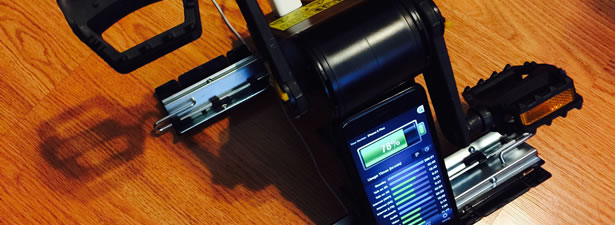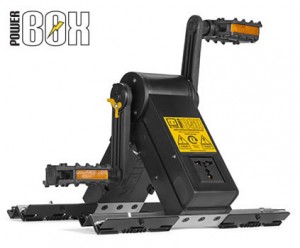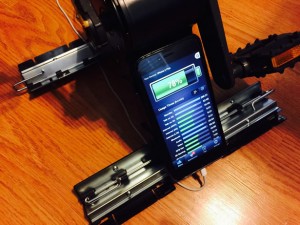K-TOR Power Box Reviewed

Marketing from K-TOR
The Power Box is a pedal generator that can be used with your legs or arms. It generates electricity as you pedal, like on a stationary bicycle. Charge the batteries of a full range of portable electronics. Or, charge external batteries to power laptops and all kinds of appliances — either directly from the batteries or through an inverter. The Power Box has a universal outlet. It allows you to plug in chargers from anywhere in the world to charge your portable electronics. The Power Box is a great addition to emergency and survival kits.
Manufacturer: K-TOR, www.k-tor.com
Model: Power BoxDimensions (Folded): 12″ x 5.5″ x 3.5″
Dimensions (Deployed): 13″ x 11.25″ x 8.25″
Weight: 4 lbs 11 ozOutput: 20W 120V DC @2Hz
MSRP: $195.00
The Review
What do you do when you are bugging out at the cabin, or bugging in and the power has been out for a few days? There is nothing more frustrating than watching the power level on your electronic devices drop to zero when you need them the most. Today we’ll be talking about K-TOR’s Power Box, a rugged pedal-crank generator capable of producing as much as 20 watts of DC electricity day or night. All while you get in your daily exercise in.
 K-TOR’s Power Box is a compact, pedal-crank generator capable of providing up to 20 watts of 120V DC power to a Universal Socket simply by rotating the charging arm at a steady 90 RPM (1.5 revolutions per second). The DC (Direct Current) power generated by the Power Box is nearly the same as the AC (Alternating Current) household outlets are commonly powered with except that DC slightly more efficient than AC in most cases.
K-TOR’s Power Box is a compact, pedal-crank generator capable of providing up to 20 watts of 120V DC power to a Universal Socket simply by rotating the charging arm at a steady 90 RPM (1.5 revolutions per second). The DC (Direct Current) power generated by the Power Box is nearly the same as the AC (Alternating Current) household outlets are commonly powered with except that DC slightly more efficient than AC in most cases.
It is important to note that the Power Box WILL NOT power microwaves, refrigerators, TVs, or any other appliances that requires an AC current to operate. K-TOR also has a special 12-volt charging adapter for charging sealed lead acid batteries available for purchase from the K-TOR webstore. It is capable of providing up to 13.8V, .7A while charging.
The Power Box provides plenty power to charge most laptops, tablets, smartphones and rechargeable batteries that use a switching power adapter. It is estimated that one minute of cranking could produce as much as one minute of talk time for some cell phones, and much less for smartphones. Rechargeable flashlights and batteries would likely see much stronger gains per minute of charging.
The speed in which a device can be charged is limited only by the charging device itself. Typical USB charging adapters provide power at a standard rate (5V, 1A) to the device. However, some of the newer quick-charging systems require twice as much power (5V, 2A), and others require as much as four times as much power (9V, 2A) which is still within the limits of what the Power Box can generate.
Most small-device chargers will operate on less than 10 watts of power so it may be possible to charge more than one device at a time with the Power Box. To determine what a charging adapter utilizes, simply multiply the output voltage of the device by the output amperage of the device to find its power use. This is typically printed on the device itself. For example, a device with an output of 5V, 1A requires 5 watts of power, a device with an output of 5V, 2A requires 10 watts or power, and a device with an output of 9V, 2A requires 18 watts of power. All below the Power Box’s maximum output.
The pedal-crank generator was designed and assembled at K-tor’s facility located in Vermont with 70% of the components supplied by US manufacturers. Weighing in at 4 pounds 11 ounces, the Power Box is 5.5″ wide, 3.5″ tall and 12″ in length collapsed, and 13″ wide, 8.25″ tall and 11.25″ in length fully assembled and can be screwed down to stabilize the unit if necessary. It is certainly compact enough to stow away as a backup power source in the event of an emergency.
The powertrain consists of a series of durable nylon gears tightly spaced to efficiently convert the mechanical rotation of the pedal-crank with as little efficiency loss as possible. The Power Box generator has an efficiency rate of 85%. As a result, turning the crank 1.5 times per second in turn spins the generator at 3000 RPMs to generate the 20 watts of DC power.
The housing is constructed from a rugged polycarbonate plastic for its strength and durability to provide years of service under normal use and conditions. All pins, stamped feet and cast cranks are galvanized to prevent rust and corrosion.
The electronics components have been engineered to provide increased durability and serviceability of the circuitry, connectors and generator resulting in a more efficient generation of power.
If the pedal-crank ever becomes difficult to turn, do not force it or risk damaging the Power Box. The Power Box comes with a one-year warranty. K-Tor also has a recycling program that provides very reasonable repair rates and replacement parts should they ever wear out.
K-Tor has a policy of continuous improvement. If a piece ever fails we look for ways to make it more robust so that we deliver the most reliable product possible. We test 100%, twice independently.
Functional Testing
For my first test, I used a plain old 120-volt desk lamp with a 6W LED bulb. I plugged the lamp into the Power Box and began to turn the pedal-crank. The first few turns had quite a lot of resistance, but shortly afterward the bulb lit brightly and the bulk of the resistance had dissipated. I tried to see how long I could keep the bulb lit brightly spinning the generator at the rate of 90 RPMs, but after a few short minutes I could really feel the burn and couldn’t go much longer than 10 minutes from a chair without resting. I suppose a better seating configuration and immobilizing the Power Box would have resulted in less fatigue.
 Next, I tried again with the same lamp, but this time with an 14W fluorescent bulb. As before, the first few turns had quite a lot of resistance before it lessened. However, I could feel there was more resistance than before to accommodate the additional 8 watts of power that it needed to generate.
Next, I tried again with the same lamp, but this time with an 14W fluorescent bulb. As before, the first few turns had quite a lot of resistance before it lessened. However, I could feel there was more resistance than before to accommodate the additional 8 watts of power that it needed to generate.
For the final test, I thought I would try charging an iPhone 6 Plus with a standard Apple 5V, 1A power adapter to see how much power would be added per minute of rotation. To help with that, I decided it would be best to set the phone to Airplane Mode during the charging process so it would not use any online resources, but would not require a bootup.
After 5 minutes of pedalling the Power Box with the iPhone 6 Plus in Airplane Mode, I saw an estimated gain of 56 seconds of 3G talk time. I ran the exact same 5 minute test while plugged into a wall socket using the same adapter, also resulting in a 56 second talk time gain. I experienced no difference between the generator and the wall socket at all. However, I did find that the mechanical generation of power does require a lot of physical effort.
Final Thoughts
There are many fine passive generators on the market these days that will charge a phone, tablet, flashlight or batteries effortlessly provided the sun is out. But what about charging a laptop? What about charging at night or when it is raining? Enter the Power Box… A rugged pedal-crank generator perfect for those stressful situations when you might need a little boost of power to make an emergency call or provide a few minutes of light.
At nearly 5 pounds, this is not a device that you will be packing in your bug out bag, but it could be very handy to have on hand if you are bugging in during a power outage or grid collapse, or to stow in your boat or at your cabin.
The Power Box is strictly an emergency power generator, and not a complete solution for producing energy. However, it fits nicely as part of a larger energy solution that may also include wind, solar and gas-powered generators.
![]()
About K-TOR
 K-TOR®, LLC is an innovative technology company that specializes in developing and manufacturing human energy driven portable power generators. The company is based in Colchester, Vermont and its high quality products are manufactured in the U.S.
K-TOR®, LLC is an innovative technology company that specializes in developing and manufacturing human energy driven portable power generators. The company is based in Colchester, Vermont and its high quality products are manufactured in the U.S.
Global Mission
Our mission is to provide electricity to every person in the world. We work towards succeeding in this mission by developing and manufacturing sustainable, green, human energy generators that are portable and reliable enough to operate anywhere on the planet.
Service & Support
K-TOR® is committed to providing excellent customer service in a timely manner. Service and support, like our manufacturing is based in the U.S. Responses to customer inquiries are made quickly and, often, by Ken himself.
--